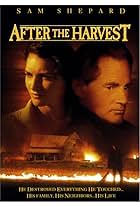A look at the life of the thoroughbred filly that dominated horse racing in the early 1970s.A look at the life of the thoroughbred filly that dominated horse racing in the early 1970s.A look at the life of the thoroughbred filly that dominated horse racing in the early 1970s.
- Awards
- 4 nominations total
Photos
- Director
- Writers
- All cast & crew
- Production, box office & more at IMDbPro
Featured reviews
As an avid fan of Thoroughbred horse racing, and someone who followed Ruffian's career including witnessing her final race, I was pleasantly surprised by this made-for-TV film. Earlier in the day, the ABC network broadcast the Belmont Stakes in which viewers saw the unique character befitting many of the long-time sportswriters who cover Thoroughbred racing. Unfortunately for the film, Frank Whaley failed to deliver that persona in the key role of sportswriter Bill Nack. However, Sam Shepard in the starring role of trainer Frank Whiteley gave a most believable performance, capturing the real life trainer's restrained professionalism. While the film's setup for the Sorority Stakes was good, I would like to have seen more background as a lead into each of the races depicted. The writers capably demonstrated how the horse, even against the wishes of its trainer, was secondary to "filling the stands" for the moguls of the racing industry. To his credit, French-Canadian director Yves Simoneau did not overly dramatize the horse's final moments, instead, effectively borrowing the eye/lash closeup created by Krzysztof Kieslowski in his French-language film, "Trois couleurs: Bleu"
More annoying to me than the horse racing inaccuracies were the portrayals of journalists who covered Ruffian. This was 1975 -- not 1935. Snap-brim hats with "Press" cards stuck in them were long gone by the 1970s. And the newsroom at Newsday, Nack's employer, was a joke. The place looks like it's a weekly, with perhaps five people working in it, rather than a major paper with a circulation of several hundred thousand and hundreds of reporters and editors. And there's always only one editor around. Moreover, Nack's desk, which for some crazy reason has an adding machine on it, is nearly empty and spotless -- which could never happen. And he has a 1950s vintage manual typewriter. Even in 1975, most big newspapers had electric typewriters.
Getting the little stuff right always helps to make the big picture better.
Getting the little stuff right always helps to make the big picture better.
I was and never have been an avid horse race watcher,but when I was ten years old,while looking for something to watch on television,I stumbled across a race consisting of two horses,one of which was named Ruffian.I remember the name because of the tragic event that took place and recall very little else about it.I remember Ruffian being badly injured and eventually having to be put down.I remember thinking how sad this was,and over the years,having heard next to nothing about it,have recalled it from time to time over the next thirty or so years.When I saw that a movie was made about her and that tragic day,I had to see it.Details that had been vague to me were brought to light.If the story told here was accurate,this was obviously a much loved,very majestic animal destined for greatness.To think that her life was cut short by some insignificant,over-hyped battle of the sexes mishmash is not only sad,it's infuriating.If anything good has come from that day,it's that challenge races no longer exist,thank goodness.
The 1970s were the height of the battle of the sexes. Men and women were in open combat, anywhere and everywhere: tennis (Riggs vs. King), the voting booth (ERA), and, on July 6, 1975, Belmont Park, when the undefeated Ruffian was sent off at 1-20 odds (you had to lay 20-1 odds on her) to defeat the Kentucky Derby winner, Foolish Pleasure, mediocre in comparison to Ruffian.
Period pieces are not easy to shoot, since they are done from memory and historical records. I was alive and following the New York tracks as a youth, and became aware of Ruffian in the spring of 1975, after she had blazed her way onto the front pages as a legitimate Kentucky Derby threat. Today, she would have run for the roses without a second thought, but her owners were old-school and gave it not a second thought.
This film captures the phenomenon that was Ruffian, from promising ace-in-the-barn that her trainer knew would win her debut at 4-1, but not by 15 lengths in 1:09. No matter how good they look in training, you never know what's going to happen when they actually run. Ruffian answered every question asked of her, even winning when slightly injured, finding the heart to put away her strong-but-weaker peers.
Ruffian was a freight train, and while the details of the film were glossed over, this was a TV film and that is often the case. Watch "Babe Ruth" from 1991 (TV) and "The Babe" from 1992 (Feature Film) for simimlar disparity. Indeed, you could also read the "Seabiscuit" book from 1997, and find it much richer than its paperback predecessor, "Come On, Seabiscuit!" from 1975.
This was the discount version of the Ruffian story. The big-budget treatment she may one day get awaits.
Ruffian was the first horse ever buried in the infield at Belmont Park. That is how special she was. She died of a broken leg because horses like her cannot live even long enough to recover on one, as they are simply born to run, her like no other.
Period pieces are not easy to shoot, since they are done from memory and historical records. I was alive and following the New York tracks as a youth, and became aware of Ruffian in the spring of 1975, after she had blazed her way onto the front pages as a legitimate Kentucky Derby threat. Today, she would have run for the roses without a second thought, but her owners were old-school and gave it not a second thought.
This film captures the phenomenon that was Ruffian, from promising ace-in-the-barn that her trainer knew would win her debut at 4-1, but not by 15 lengths in 1:09. No matter how good they look in training, you never know what's going to happen when they actually run. Ruffian answered every question asked of her, even winning when slightly injured, finding the heart to put away her strong-but-weaker peers.
Ruffian was a freight train, and while the details of the film were glossed over, this was a TV film and that is often the case. Watch "Babe Ruth" from 1991 (TV) and "The Babe" from 1992 (Feature Film) for simimlar disparity. Indeed, you could also read the "Seabiscuit" book from 1997, and find it much richer than its paperback predecessor, "Come On, Seabiscuit!" from 1975.
This was the discount version of the Ruffian story. The big-budget treatment she may one day get awaits.
Ruffian was the first horse ever buried in the infield at Belmont Park. That is how special she was. She died of a broken leg because horses like her cannot live even long enough to recover on one, as they are simply born to run, her like no other.
Movies hardly ever get horse racing right. Seabiscuit was the closest approach I have seen, but even that movie had problems. Ruffian is loaded with problems.
WHY WHY WHY do movies with racing invariably confabulate odd little human subplots that anyone with any knowledge of the sport knows are pure hokum? I do KNOW the sport, having raised, handled, and raced my own horses, and having written about the sport professionally. The actual history of Ruffian was compelling enough without the make-believe elements of this movie.
The horses used to portray the title character were some of the coarsest, plainest beasts imaginable. Ruffian--the real one--was a tall, nearly 17 hand filly, quite leggy and graceful. With all the cast-off TBs available for purchase on a per-pound meat price basis, couldn't at least one been found for close shots that did not look like a chunky pony???
I am sure that many people in racing would have cheerfully advised the movie's makers on details, gratis, just to be sure things were not gotten laughably wrong. The notion that Claiborne Farm, in the 1970s, shipped horses in a rusty beige trailer with "CF" on the side is silly. Claiborne was and is one of the last remaining family, multi-generational outfits, and has been involved not just with foaling and raising good horses, but in shaping and influencing the breed globally. It is not a marginal operation without presence or reputation. Go to the farm, and note that the gates, the (very large) water tower, the trim on the main stallion barn--are all painted Cadmium Yellow, the farm colors. Rusty beige trailers? Pulled by aged pickup trucks? I think not.
This was a FICTIONAL movie appropriating the name of a real filly, and beyond that, not much more. It was never really explained why Ruffian was extraordinary--the movie makers seemed confused between stakes record time and track record time--or that she had an average winning margin of 7 lengths after 10 races, or that there has never been anything like her since, and in what seems a glaring omission, there was no hint of all the advances in caring for catastrophic breakdowns since 1975. Foolish Pleasure's reputation was inflated beyond what it was at the time--he was a good 3-y-o, but not a great one, and he finished his days in obscurity, pasture-breeding mares somewhere out west.
No wonder Frank Whiteley and Jacinto Vasquez sought to legally block the airing of this movie without adequate disclaimers.
WHY WHY WHY do movies with racing invariably confabulate odd little human subplots that anyone with any knowledge of the sport knows are pure hokum? I do KNOW the sport, having raised, handled, and raced my own horses, and having written about the sport professionally. The actual history of Ruffian was compelling enough without the make-believe elements of this movie.
The horses used to portray the title character were some of the coarsest, plainest beasts imaginable. Ruffian--the real one--was a tall, nearly 17 hand filly, quite leggy and graceful. With all the cast-off TBs available for purchase on a per-pound meat price basis, couldn't at least one been found for close shots that did not look like a chunky pony???
I am sure that many people in racing would have cheerfully advised the movie's makers on details, gratis, just to be sure things were not gotten laughably wrong. The notion that Claiborne Farm, in the 1970s, shipped horses in a rusty beige trailer with "CF" on the side is silly. Claiborne was and is one of the last remaining family, multi-generational outfits, and has been involved not just with foaling and raising good horses, but in shaping and influencing the breed globally. It is not a marginal operation without presence or reputation. Go to the farm, and note that the gates, the (very large) water tower, the trim on the main stallion barn--are all painted Cadmium Yellow, the farm colors. Rusty beige trailers? Pulled by aged pickup trucks? I think not.
This was a FICTIONAL movie appropriating the name of a real filly, and beyond that, not much more. It was never really explained why Ruffian was extraordinary--the movie makers seemed confused between stakes record time and track record time--or that she had an average winning margin of 7 lengths after 10 races, or that there has never been anything like her since, and in what seems a glaring omission, there was no hint of all the advances in caring for catastrophic breakdowns since 1975. Foolish Pleasure's reputation was inflated beyond what it was at the time--he was a good 3-y-o, but not a great one, and he finished his days in obscurity, pasture-breeding mares somewhere out west.
No wonder Frank Whiteley and Jacinto Vasquez sought to legally block the airing of this movie without adequate disclaimers.
Storyline
Did you know
- TriviaBecause Ruffian was such a large filly, larger even than many colts (including Foolish Pleasure), they used geldings to portray her in the film.
- GoofsIn certain camera angles, it can be seen that the horses playing Ruffian are actually male ( geldings) and not fillies.
- ConnectionsFeatured in 14th Annual Screen Actors Guild Awards (2008)
Details
- Release date
- Country of origin
- Language
- Also known as
- Ruffian, a csodakanca
- Filming locations
- Production companies
- See more company credits at IMDbPro
Contribute to this page
Suggest an edit or add missing content

























